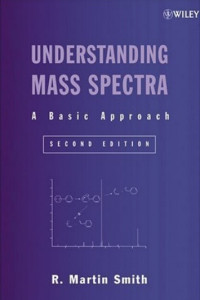
Electronic Resource
UNDERSTANDING MASS SPECTRA : A BASIC APPROACH Second Edition
Mass spectrometry (MS) differs from other common forms of organic spectral analysis in that the sample does not absorb radiation such as infrared, ultraviolet, or radio waves from the electromagnetic spectrum. In contrast to infrared (IR) or nuclear magnetic resonance (NMR) spectrometry, both of which identify compounds with specificity comparable to that of mass spectrometry, MS is a destructive method of analysis—that is, the sample cannot be recovered after mass spectral analysis. On the other hand, MS is highly sensitive and requires less sample than either IR or NMR in order to provide more information about the structure of the analyte. Mass spectrometers are typically not standalone instruments. Most often they are connected physically and electronically to a chromatograph as well as a computer. Figure 1.1 shows a typical arrangement of a chromatograph/mass spectrometer/ computer system. The chromatograph separates mixtures and introduces the sample into the mass spectrometer. The mass spectrometer ionizes analyte molecules, then separates and detects the resulting ions. The computer system controls the operation of the chromatograph and the MS, and provides data manipulation and storage during and after data collection. For volatile samples, gas chromatography (GC) is used for mixture separation. For nonvolatile or thermally labile molecules, high pressure liquid chromatography (HPLC or just LC) is used. The abbreviated terms GC/MS and LC/MS are commonly used to describe the combination of these chromatographic techniques with MS.
Ketersediaan
| EBK-00232 | 543.0873/Smi-u | Perpus Pusat | Tersedia |
Informasi Detail
- Judul Seri
-
-
- No. Panggil
-
543.0873/Smi-u
- Penerbit
- Canada : Jhon Wiley and Sons., 2004
- Deskripsi Fisik
-
387 hlm
- Bahasa
-
Indonesia
- ISBN/ISSN
-
0-471-42949-X
- Klasifikasi
-
543.0873
- Tipe Isi
-
text
- Tipe Media
-
e-book
- Tipe Pembawa
-
-
- Edisi
-
Ed.2
- Subjek
- Info Detail Spesifik
-
Electronic Version
- Pernyataan Tanggungjawab
-
-
Versi lain/terkait
Tidak tersedia versi lain
Lampiran Berkas
Komentar
Anda harus masuk sebelum memberikan komentar
 Karya Umum
Karya Umum  Filsafat
Filsafat  Agama
Agama  Ilmu-ilmu Sosial
Ilmu-ilmu Sosial  Bahasa
Bahasa  Ilmu-ilmu Murni
Ilmu-ilmu Murni  Ilmu-ilmu Terapan
Ilmu-ilmu Terapan  Kesenian, Hiburan, dan Olahraga
Kesenian, Hiburan, dan Olahraga  Kesusastraan
Kesusastraan  Geografi dan Sejarah
Geografi dan Sejarah